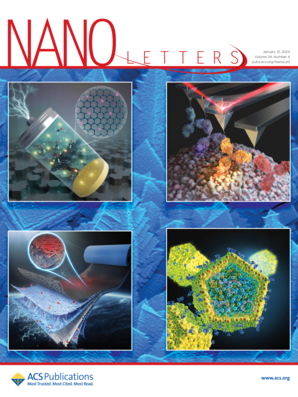Topological Band Engineering in q-BICs and EPs Derived from Visible Range Plasmons
IF 9.6
1区 材料科学
Q1 CHEMISTRY, MULTIDISCIPLINARY
引用次数: 0
Abstract
Topological photonics, owing to its band topology, has substantial potential in applications such as quantum computation and photonic chips. However, attaining flexible control over band topology for effective light–matter interactions at the subwavelength scale remains elusive. In this study, we present a metal–insulator–metal (MIM) dimerized grating structure based on the one-dimensional (1D) Su–Schrieffer–Heeger model (SSH). This structure is designed for tuning optical band topology with a relatively high quality factor and small mode volume. Specifically, by variation of the grating thickness, topological band inversion with plasmonic quasi-bound states in the continuum (q-BICs) can be achieved. Moreover, through the modulation of gain–loss and coupling strength, the corresponding exceptional points (EPs) can emerge near the Brillouin zone center (Γ point). Consequently, this MIM dimerized grating structure offers a novel approach for the design of advanced topological devices.

求助全文
约1分钟内获得全文
求助全文
来源期刊

Nano Letters
工程技术-材料科学:综合
CiteScore
16.80
自引率
2.80%
发文量
1182
审稿时长
1.4 months
期刊介绍:
Nano Letters serves as a dynamic platform for promptly disseminating original results in fundamental, applied, and emerging research across all facets of nanoscience and nanotechnology. A pivotal criterion for inclusion within Nano Letters is the convergence of at least two different areas or disciplines, ensuring a rich interdisciplinary scope. The journal is dedicated to fostering exploration in diverse areas, including:
- Experimental and theoretical findings on physical, chemical, and biological phenomena at the nanoscale
- Synthesis, characterization, and processing of organic, inorganic, polymer, and hybrid nanomaterials through physical, chemical, and biological methodologies
- Modeling and simulation of synthetic, assembly, and interaction processes
- Realization of integrated nanostructures and nano-engineered devices exhibiting advanced performance
- Applications of nanoscale materials in living and environmental systems
Nano Letters is committed to advancing and showcasing groundbreaking research that intersects various domains, fostering innovation and collaboration in the ever-evolving field of nanoscience and nanotechnology.
 求助内容:
求助内容: 应助结果提醒方式:
应助结果提醒方式:


